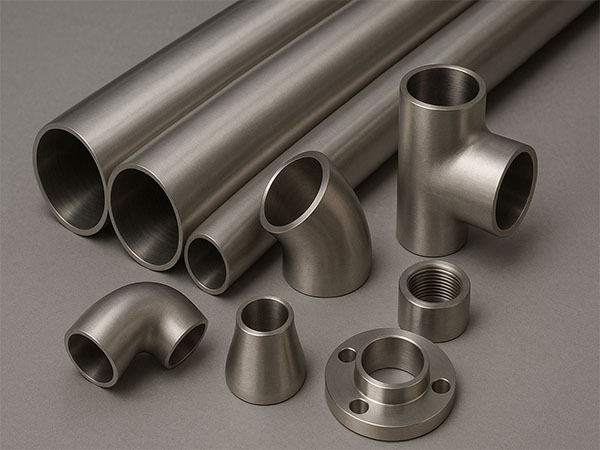In industrial pipeline systems,
stainless steel pipes, as the main pressure-bearing components for transporting media, are widely used due to their excellent corrosion resistance, high-temperature resistance and strength advantages. Stainless steel pipe fittings are key components for achieving functions such as interconnection, diversion or steering in pipeline systems. The two are highly consistent in material composition, manufacturing standards and dimensional fit to ensure the sealing performance and overall reliability of the pipeline system.
Stainless steel pipe
Stainless steel pipes are metal tubes with hollow cross-sections, used for fluid transportation or as structural components. Their main features are corrosion resistance, high-temperature resistance, and pressure resistance, and they can operate stably for a long time in various chemical media and environments.
Its alloy composition mainly consists of iron and chromium, with the addition of elements such as nickel and molybdenum to form a dense chromium oxide film, achieving self-passivation protection and further enhancing resistance to pitting and crevice corrosion.

According to the production process, stainless steel pipes can be divided into two major categories: seamless steel pipes and welded steel pipes.
Stainless steel seamless tubes: Formed by integral forging and rolling or rolling, without welds, they have the advantages of uniform wall thickness and high strength, and are often used in high-temperature, high-pressure and corrosive fields.
Welded stainless steel pipes: They are made by rolling stainless steel plates or stainless steel strips into shape and then welding them. According to the different weld seams, they can be further classified into various forms such as resistance welding, TIG/MIG welding, etc. They are suitable for medium and low pressure transportation and general engineering applications.
The common grades of stainless steel pipes generally include austenitic stainless steels such as 304 and 316, as well as ferritic stainless steels such as 409 and 430. Different grades of stainless steel have their own focuses in terms of corrosion resistance and mechanical properties.
The common execution standards for stainless steel pipes include ASTM A312 (seamless/welded Austenitic stainless steel pipes) and international norms such as DIN and JIS.
Stainless steel pipe fittings
Stainless steel pipe fittings refer to metal fittings used for connecting, turning, branching or changing the diameter of pipes. They possess corrosion resistance, high-temperature resistance and pressure resistance, and belong to the stainless steel family along with pipes. They are widely used in industries such as petroleum, chemical engineering, food and medical care.
Typical functions include: changing the flow direction (such as elbows), branch pipelines (such as tees), adjusting the diameter (such as reducers), disassembly, assembly and maintenance (such as flanges), etc.
The common types of stainless steel pipe fittings are as follows:
Elbows: They are classified by Angle into 45°, 90°, 180°, etc., and are used to change the direction of pipes. Common connection methods include welding, threading, socket welding, etc.
Three-way: Dividing the main and branch pipelines into two streams or merging them.
Large and small heads: Achieve smooth transitions for pipes of different diameters.
Flange: It connects pipeline equipment or other pipe fittings through bolts and provides disassembly and maintenance points.
Joints and clamps: Convenient for quick disassembly, assembly and maintenance.
Pipe fittings are mostly made of the same material as the pipe materials (such as 304/316), and follow standards such as ASME B16.9, B16.11, ANSI/ISO, etc., to ensure that the dimensions, wall thicknesses, pressure grades are completely matched with the corresponding pipe materials and guarantee the overall performance of the system.
The relationship and coordination between pipes and pipe fittings
Material compatibility: Pipes and pipe fittings should be made of stainless steel pipes of the same or similar grades to ensure consistent electrochemical behavior in the same medium and environment, and to avoid galvanic corrosion and local corrosion failure caused by material differences.
Size and standard fit: The dimensions of pipe fittings (diameter, wall thickness, pipe scheduling "SCH" or "STD") must strictly correspond to the pipe material. Common fit methods include welding butt joint, threaded connection, socket welding connection, etc. Implement unified standards (such as ASTM/ASME or GB/T) to ensure the mating accuracy and sealing performance of the interfaces.
System integration and application: In fields such as petrochemicals, food, medicine, and Marine engineering, pipes provide the "channels" for transporting media, while pipe fittings assemble the pipeline network into an integrated system that meets process requirements through various connection forms. The collaboration between the two ensures safe, efficient, and easy-to-maintain transportation. The correct selection and installation of pipes and pipe fittings is the foundation for the long-term stable operation of pipeline systems.
